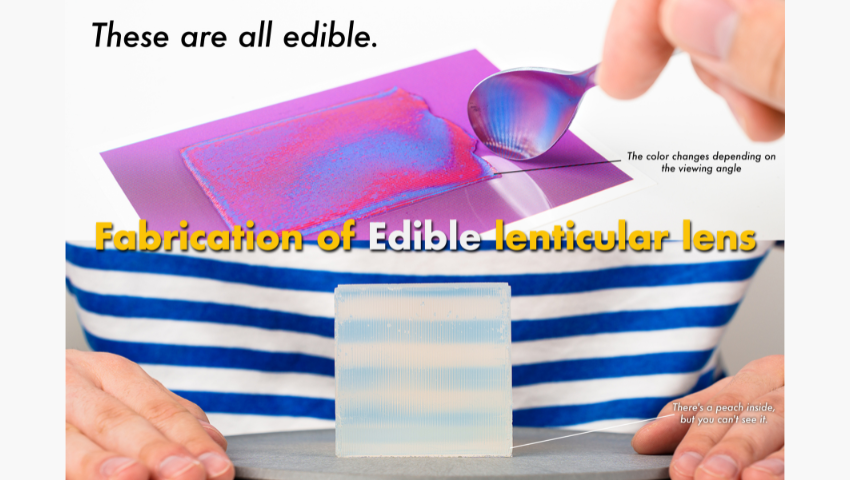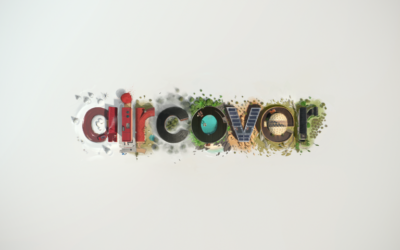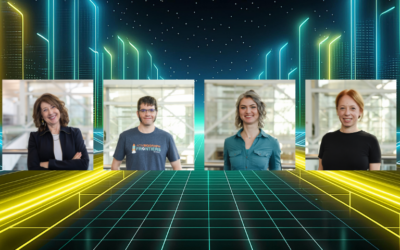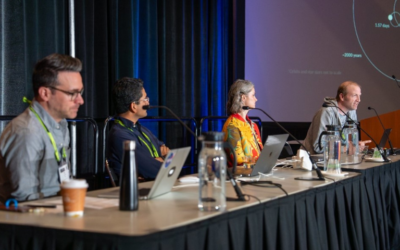See how Takegi Yoshimoto created an edible lenticular lens system that changes the appearance of the cuisine depending on the viewpoint, and how he developed his SIGGRAPH 2023 Poster.
SIGGRAPH: Give us a summary of what an edible lenticular lens design system is.
Takegi Yoshimoto (TY): The edible lenticular lens design system consists of software for designing and hardware for fabrication. The software allows users to design lenticular lenses with arbitrary specifications, including pitch and curvature radius and preview the effect through ray-tracing simulations. The hardware allows users to precisely fabricate these designs using the knife-cutting method.
SIGGRAPH: What was your intention in creating software that allows someone to change the appearance of food? What inspired this?
TY: By applying an edible lenticular lens to cuisine, it is possible to interactively change the appearance of the cuisine depending on the viewpoint. The changing appearance enables different visual expressions according to sitting position and posture while sharing the experience of gathering around the same dining table. This is the kind of experience that cannot be realized with HMDs or projection mapping projected on the table in which each person sees the images. We are trying to realize a more interactive and rich gastronomic experience through dishes that can display multi-viewpoint information.
SIGGRAPH: Explain some of the tools or techniques that were used in the creation and execution of edible lenticular lens. Tell us more about how you developed and introduced fabrication methods, like using a 3D-printed knife with the inverse structure of a lenticular lens.
TY: As design software for edible lenticular lenses, we have our own design tool implemented using Grasshopper and V-ray. With this tool, users can design the visual effect of the lens and confirm its visual effect through ray-tracing simulation. Users can then output a 3D model to fabricate the designed lens. The hardware for fabricating edible lenticular lenses includes a fabrication machine that utilizes a stepper motor and a 3D-printed knife with the inverse structure of the designed lenticular lens. The 3D-printed knife is made of biocompatible materials, making it safe to use as a cooking utensil.
SIGGRAPH: What problems does your edible lenticular lens design system solve? How do you envision it being used in the future?
TY: The system makes it possible to produce edible lenticular lenses, for which it has been difficult to predict the visual effect after completion. The system also enables users to customize the pitch and curvature radius of edible lenticular lenses to their desired shape. After SIGGRAPH 2023 Posters, we developed a dish using edible lenticular lenses with the French restaurant “élan vital”. In this dish, the image changes from Fine Breezy Day (Gaifu kaisei) and The Great Wave Off Kanagawa (Kanagawa oki-nami-ura), both from the series Thirty-six Views of Mount Fuji (Fugaku sanjurokkei), depending on the viewpoint. Lenticular images were printed on ceramics using porcelarts, and edible lenticular lenses made of agar and dashi are placed on top of them. This dish is currently served at their restaurant in Tokyo. We hope that this system and technology will be introduced to innovative restaurants around the world and served in a variety of culinary forms, such as the aforementioned edible lenticular cuisines.
SIGGRAPH: Share with us how you developed your poster. Did you experience any challenges? How did you overcome them?
TY: The challenge was to reduce the gap between the optical properties of jelly and glass as materials. For example, the refractive index of jelly in the fabrication method proposed in the poster is 1.34, while the typical refractive index of glass is about 1.5. The lower refractive index of the jelly material requires a longer focal length to achieve the desired visual effect, but if the jelly is too large as a food product, it will be difficult to eat. We challenged ourselves to successfully adjust those trade-offs. In our later published research, “Edible Lenticular Lens Design System,” we proposed a shape design that matches materials with different respective refractive indices. Currently, my research is mainly focused on a material called gellan gum, but I would like to challenge different materials such as agar, gelatin, and candy.
SIGGRAPH: What advice would you give to those submitting a poster to SIGGRAPH 2024?
TY: The poster session at SIGGRAPH is a valuable opportunity to present your research to a large audience. However, you must accurately convey the purpose, significance, novelty, and utility of your research in the limited space of two pages in your poster manuscript. It may be a major step toward a successful SIGGRAPH Poster to appropriately summarize the content of the research you wish to convey and to create a manuscript that is easy for the reader. It is important to polish your manuscript to convey your research in an attractive and theoretical manner within a limited amount of time.
The SIGGRAPH Posters program is an interactive forum where students, researchers, artists, enthusiasts, and practitioners present their latest novel ideas and ongoing research. Submit to Posters by 25 April.

Takegi Yoshimoto is a human-computer interaction researcher. He specializes in “edible optics” and “digital fabrication”. He is working on realizing foods with various optical properties through the use of computer simulation and 3D printing technology. Through this technology, he creates foods with special visual effects and explores new forms of interaction between food and people.



